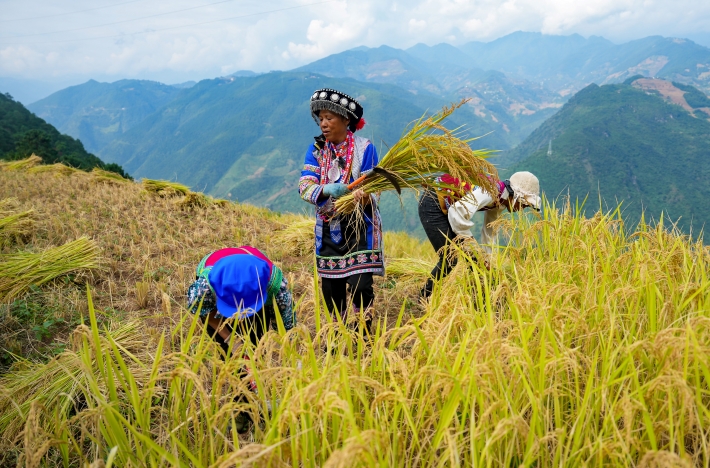|
||||||||||
| Home Top News Economy/Tech Culture/Sports China in Foreign Eyes Green Development Videos Intangible Cultural Heritages |
|
||||||||||
| Home Top News Economy/Tech Culture/Sports China in Foreign Eyes Green Development Videos Intangible Cultural Heritages |
| ChinAfrica |
| From Barren Land to Golden Harvest |
| Nujiang farmers use the innovative dryland rice cultivation technology developed by a Chinese expert team to grow yields and income |
| By Xia Yuanyuan | VOL. 17 May 2025 ·2025-05-06 |

Farmers harvest rice in the dryland rice fields of Ziji Village, Daxingdi Town, Lushui City, Nujiang Lisu Autonomous Prefecture, Yunnan Province, on 24 September 2024 (XINHUA)
As April ushers in spring, mist clings to the deep valleys of the Nujiang Grand Canyon in Southwest China’s Yunnan Province. High on a mountainside in Ziji Village, Daxingdi Town, Lushui City, Nujiang Lisu Autonomous Prefecture, at an altitude exceeding 1,300 metres, 62-year-old Lisu villager Cha Wenxing is planting rice. These demonstration plots, cultivating high-quality upland rice, seem to float amongst the clouds.
Having spent his life farming, Cha never imagined rice could be grown on such arid terrain. Yet, thanks to the efforts of Zhu Youyong, an academician of the Chinese Academy of Engineering, and his team, more canyon residents like Cha are transforming “sky-dependent fields” into bountiful rice paddies, relishing the fragrant rice cultivated on their own land.
Quest for food security
High mountains and deep gorges cover more than 98 percent of the land in Nujiang Lisu Autonomous Prefecture, which is nestled in the heart of the Hengduan Mountains in northwest Yunnan. Steep slopes, thin topsoil, and scarce irrigation present formidable obstacles to agriculture.
For centuries, the Lisu, Nu, and other ethnic groups native to this region have primarily survived on hardier crops like maize and potatoes. Grain yields were typically low and unpredictable, heavily reliant on rainfall. Consequently, securing sufficient food - particularly rice - remained a constant struggle for many families, making home-grown rice an almost unattainable luxury.
Traditional upland rice varieties offered little respite. While able to grow in drier conditions, their yields often languished around 150 kg per mu (about 2,250 kg per hectare), far below subsistence needs. Raising grain production on the limited, infertile, and dry sloping farmland was absolutely necessary to ensure local food security. The breakthrough came through scientific innovation led by academician Zhu and his team, who focused their expertise on this challenging terrain.
After more than a decade of dedicated research and experimentation, they developed an upland rice cultivation technology that revolutionised grain production in Nujiang.
Technology transforms tradition
The upland rice cultivation technology introduced by Zhu’s team centres on hybrid varieties bred using modern biotechnology. Cultivars such as Dianheyou 615 and Dianheyou 918 possess strong drought resistance and extensive root systems, enabling them to thrive primarily on natural rainfall. Planted directly onto slopes previously used for maize or other dry crops, using direct or row seeding methods, this approach circumvents the laborious traditional methods of soaking fields, nurturing seedlings, and transplanting. Even during critical growth periods, only minimal “lifesaving water” might be needed in extreme drought, drastically reducing dependence on irrigation infrastructure.
However, promoting this innovation faced initial headwinds. Misunderstandings arose, with some expressing concern that the method might amount to deforestation of the farmland, potentially damaging the fragile ecosystem. Zhu emphatically refuted the concern: “Our initiative does not involve clearing forests or reclaiming barren hillsides for rice, nor pumping water uphill to create paddy fields.”
“We are utilising existing arable slopes previously cultivated with maize and potatoes. The key is adapting rice varieties to mountain conditions through science, not forcing the mountains to fit traditional rice cultivation,” Zhu clarified.
Improving lives
The tangible benefits of high-quality upland rice are transforming lives and livelihoods in Nujiang. Su Luyi, a villager from Daliandi Village in Lushui City, was an early adopter. He talked about the difference the technology has made: Previously, this sloped land could only grow maize, yielding a few hundred kg per mu (0.067 hectares), and selling for 3 yuan ($0.41) per kg. Now, with upland rice, yields reach 350 to 500 kg per mu (about 5,200 to 7,500 kg per hectare) and the produce sells for 6 yuan ($0.82) per kg. “The conclusion is simple: Rice is far more profitable,” he said.
Inspired by such results, entrepreneurial farmers are forming specialised cooperatives. They are leasing land across mountainous and semi-mountainous areas in towns like Shangjiang and Daxingdi for larger-scale upland rice cultivation, creating new means for rural development and farm income increase.
The rapid adoption of this technology is reflected in official figures from the Nujiang Prefecture Agriculture and Rural Affairs Bureau. From a mere 16.9 mu (about 1.13 hectares) under demonstration planting in 2022, the cultivated area surged dramatically. By the spring planting season of 2024, the total area dedicated to high-quality upland rice across the prefecture had reached 14,372.5 mu (about 958 hectares).
This agricultural transformation underscores the power of targeted scientific innovation to enhance food security and economic prospects in challenging mountain environments.
| About Us | Contact Us | Advertise with Us | Subscribe |
| Copyright Beijing Review All rights reserved 京ICP备08005356号-5 京公网安备110102005860号 |